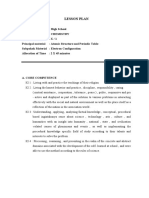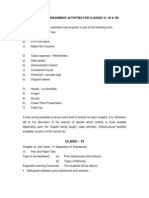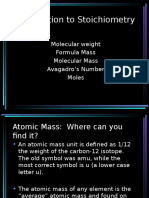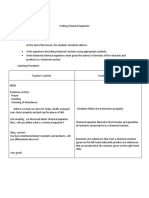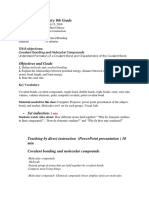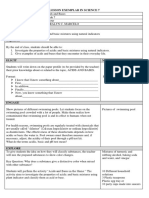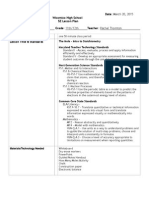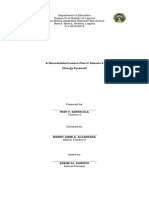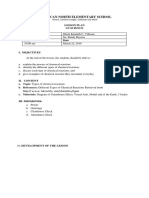Mole Games
Mole Games
Uploaded by
Ng Swee Loong StevenCopyright:
Available Formats
Mole Games
Mole Games
Uploaded by
Ng Swee Loong StevenOriginal Description:
Copyright
Available Formats
Share this document
Did you find this document useful?
Is this content inappropriate?
Copyright:
Available Formats
Mole Games
Mole Games
Uploaded by
Ng Swee Loong StevenCopyright:
Available Formats
Mole Day Planning Pack
Read out the statements below. Students decide whether the statement is true
or false. They indicate their answer in the following way:
False
Dont know
True
Sit down
Stand up
Stand up with arms in the air
Or they can always use traffic light cards!
After each question, ask a selection of students to explain the reasons for their answer.
After hearing several reasons, give the students the opportunity to change their
answer.
1. The mole is a unit.
2. The mole is a mass.
3. One mole of water (H2O) and one mole of glucose (C6H12O6) have the same
mass.
4. One mole of H2 contains the same number of molecules as one mole of CO2.
5. One mole of H2 contains the same number of atoms as one mole of CO2.
6. There are more atoms in 12 g of carbon than in 12 g of copper.
7. A mole is a molecule.
8. The mole is a number.
9. One mole of a substance contains Avogadros number of elementary entities.
10. One mole of a substance contains 6.02 x 1023 elementary entities.
11. The amount of substance is measured in kilograms.
12. The amount of substance is a volume.
13. I understand what a mole is.
Answers
1) T 2) F 3) F 4) T 5) F 6) T 7) F 8) F 9) T 10) T 11) F 12) F
http://www.ulster.ac.uk/scienceinsociety/molepack.html
finding out ideas
Mole Traffic Lights
Funded by the Royal Society of Chemistry
Mole Day Planning Pack
The words on the cards below are important in understanding the definition of the
mole. Cut out the cards.
Game 1
Hold a card above the head of a volunteer. The volunteer can ask for clues from
anyone in the class, and must keep asking until they guess the correct word above their
head.
Game 2
A variation is to ask the student with the card above their head to ask questions until
they are able to guess the word correctly.
Game 3
Ask a student to select a card. Only they read the card and then describe the idea to
the rest of the class, who guess the word on the card. The student who answers
correctly rolls a die and counts round the room from themselves to select the next
lucky student to describe the word on the card.
Kilogram
Amount
of
substance
Atom
Mole
Molecule
Carbon-12
Element
Relative
Atomic
Mass
6.02 x 1023
Avogadros
constant
Electron
Base unit
http://www.ulster.ac.uk/scienceinsociety/molepack.html
finding out ideas
The Mole: Headguess
Funded by the Royal Society of Chemistry
Mole Day Planning Pack
Option 1
Give one card to each student. They have to find their match, and can help each other.
Option 2
Give each team a set of cards. First team to match the definitions up correctly wins.
Relative
Atomic
Mass
Amount
of
substance
Isotope
Molar
mass
Avogadros
number
Atomic
number
Mole
Relative
formula
mass
The number of protons
you find in the nucleus
of an atom.
The constant for the
number of entities in
one mole: 6.02 x 1023
Mass
number
Atomic
mass
unit
The total number of
protons and neutrons
you find in the nucleus
of an atom.
Atoms which have the
same atomic number
but different mass
number.
Base quantity for which
the mole is the unit. It
is the number of
elementary entities
divided by the
Avogadro constant.
The ratio of the
average mass of the
atom to the unified
atomic mass unit
Ratio of the mass of a
molecule to the unified
atomic mass unit.
Sometimes called the
molecular weight or
relative molar mass.
One twelfth of the
mass of carbon-12.
http://www.ulster.ac.uk/scienceinsociety/molepack.html
SI base unit for amount
of substance: that
which contains the
same number of
elementary entities as
there are atoms in
0.012 kg of carbon-12.
1.66 x 10-27
Funded by the Royal Society of Chemistry
finding out ideas
Definitions Card Match
You might also like
- Elements, Compounds, Mix (1) Candy ActivityALPSDocument2 pagesElements, Compounds, Mix (1) Candy ActivityALPSchabries100% (2)
- Electrical Engineering Fundamentals - V. Del ToroDocument62 pagesElectrical Engineering Fundamentals - V. Del ToroabhinavNo ratings yet
- Lesson PlanDocument20 pagesLesson PlanYhan Brotamonte Boneo100% (1)
- Science 9 Exemplar-Melc 5Document8 pagesScience 9 Exemplar-Melc 5Thartson Oliveros MagdadaroNo ratings yet
- Science Teacher's GuideDocument2 pagesScience Teacher's GuideEldie Ocariza100% (1)
- Mole Supplemental WorksheetDocument2 pagesMole Supplemental WorksheetNg Swee Loong StevenNo ratings yet
- Ionic Formulas Lesson PlanDocument9 pagesIonic Formulas Lesson Planapi-357585508No ratings yet
- Activities For Mole ConceptDocument4 pagesActivities For Mole ConceptJunard Asentista100% (1)
- Formative Assessment Activities VI VIIIDocument20 pagesFormative Assessment Activities VI VIIISanjay SinhaNo ratings yet
- Semi-Detailed Lesson Plan For Grade 9 ScienceDocument4 pagesSemi-Detailed Lesson Plan For Grade 9 ScienceJeffrey FloresNo ratings yet
- Multiple Choice. Read Each Question Carefully and Write The Letter of The Correct Answer On The SpaceDocument5 pagesMultiple Choice. Read Each Question Carefully and Write The Letter of The Correct Answer On The SpaceLouie Jane EleccionNo ratings yet
- Curriculum Guide: Instructional PlanningDocument6 pagesCurriculum Guide: Instructional PlanningJohn Perseus LeeNo ratings yet
- Lesson Plan 7E S Metals and Non MetalsDocument2 pagesLesson Plan 7E S Metals and Non MetalsYasmin Abigail Aserios100% (1)
- BIOMOLECULES-ACTIVITY - by PartnerDocument2 pagesBIOMOLECULES-ACTIVITY - by PartnerANGELICA LITONNo ratings yet
- DLP Ionic BondDocument14 pagesDLP Ionic BondChristine Lomeda VillaNo ratings yet
- I. Objectives: Semi-Detailed Lesson Plan in Grade 9Document3 pagesI. Objectives: Semi-Detailed Lesson Plan in Grade 9Jeremy Bren Ofo-obNo ratings yet
- Science 9 Q3 Week 6Document13 pagesScience 9 Q3 Week 6Mervin LudiaNo ratings yet
- Detailed Lesson Plan: Knowledge Skills Attitudes ValuesDocument3 pagesDetailed Lesson Plan: Knowledge Skills Attitudes ValuesNouiea Bernardelle AcabalNo ratings yet
- Lesson Plan 1Document5 pagesLesson Plan 1nelmark.pepito100% (1)
- Sounds ExemplarDocument6 pagesSounds ExemplarCharolyn Centeno MenesesNo ratings yet
- Department of Education: Learning Activity SheetDocument3 pagesDepartment of Education: Learning Activity SheetKaren May UrlandaNo ratings yet
- Electronic ConfigurationDocument4 pagesElectronic ConfigurationkarlNo ratings yet
- Semi Detailed Acid and BaseDocument3 pagesSemi Detailed Acid and Basejallie niepesNo ratings yet
- Demonstrates Understanding Of: Online Resource For Middle School Chemistry. Retrieved FromDocument7 pagesDemonstrates Understanding Of: Online Resource For Middle School Chemistry. Retrieved FromRenante CruzNo ratings yet
- A Detailed Lesson Plan in Science (UNITS and MEASUREMENT)Document3 pagesA Detailed Lesson Plan in Science (UNITS and MEASUREMENT)Bemtot Blanquig100% (1)
- Lesson Plan in Mechanical EnergyDocument7 pagesLesson Plan in Mechanical EnergyNorma Lyn GarciaNo ratings yet
- Lesson Plan in ScienceDocument4 pagesLesson Plan in ScienceDaryl HilongoNo ratings yet
- Semi-Detailed Lesson Plan in Grade 9 BioDocument6 pagesSemi-Detailed Lesson Plan in Grade 9 BioPete Brana RodisNo ratings yet
- Chemistry GRADE 9 MODULE CHemical BondingDocument18 pagesChemistry GRADE 9 MODULE CHemical BondingKelvin MarinasNo ratings yet
- Daily Lesson PlanDocument8 pagesDaily Lesson PlanUdani Jaymar100% (1)
- Module 7 - Science 10 - 2019-2020Document3 pagesModule 7 - Science 10 - 2019-2020Evangeline Galac AbrilNo ratings yet
- Activity 3 - Which Heats and Cools FasterDocument2 pagesActivity 3 - Which Heats and Cools FasterJONJONNo ratings yet
- Activity Sheet-10 (Electronic Configuration)Document3 pagesActivity Sheet-10 (Electronic Configuration)Nkemzi Elias Nzetengenle100% (1)
- Week1 - July 1-4Document10 pagesWeek1 - July 1-4Louie Jane EleccionNo ratings yet
- Lesson Plan On Phase ChangesDocument5 pagesLesson Plan On Phase ChangesChristy RahonNo ratings yet
- Mole ConceptDocument29 pagesMole ConceptIdha Nurhayati0% (1)
- Lesson ExemplarDocument3 pagesLesson ExemplarMark Hernand Galapate0% (1)
- Writing Chemical EquationsDocument4 pagesWriting Chemical EquationsGlenda Cate CanaNo ratings yet
- DLL Part 1 1st QRTR g9Document6 pagesDLL Part 1 1st QRTR g9Kebu YenNo ratings yet
- STEM - GC11MP Ia B 1)Document7 pagesSTEM - GC11MP Ia B 1)HECTOR M. SALCEDONo ratings yet
- Lesson Plan Chemistry 9th GradeDocument7 pagesLesson Plan Chemistry 9th GradeRea A. BilanNo ratings yet
- 7E Lesson Plan ChemistryDocument2 pages7E Lesson Plan ChemistryGeralyn CosmeNo ratings yet
- Lesson Plan - Periodic TableDocument3 pagesLesson Plan - Periodic TableCherry Mae100% (1)
- Science 9 MDL L3 Week 4-5 PRINTEDDocument3 pagesScience 9 MDL L3 Week 4-5 PRINTEDClarice Jenn MaltoNo ratings yet
- Grade 10 Daily Lesson Plan Pasay City North High School-Tramo Campus Grade 10 ScienceDocument5 pagesGrade 10 Daily Lesson Plan Pasay City North High School-Tramo Campus Grade 10 ScienceEricha SolomonNo ratings yet
- Crossword VolcanoDocument2 pagesCrossword VolcanoraquelcoferNo ratings yet
- Date: March 20, 2015 Wicomico High School 5E Lesson Plan Subject: Honors Chemistry Grade: 11th/12th Teacher: Rachel ThorntonDocument3 pagesDate: March 20, 2015 Wicomico High School 5E Lesson Plan Subject: Honors Chemistry Grade: 11th/12th Teacher: Rachel Thorntonapi-28361150088% (8)
- Lesson Plan No 4Document6 pagesLesson Plan No 4hafeez ahmedNo ratings yet
- Activity 3 - Just Go With The FlowDocument24 pagesActivity 3 - Just Go With The FlowJessica Manawes NavorNo ratings yet
- A Lesson Plan in Science 7Document3 pagesA Lesson Plan in Science 7Ginggay Abayon Luna100% (1)
- K-12 Proposed Lesson Plan TemplateDocument4 pagesK-12 Proposed Lesson Plan TemplatePablo Ragay JrNo ratings yet
- LP Energy PyramidDocument6 pagesLP Energy PyramidNoah Gene Del RioNo ratings yet
- LP 2022Document6 pagesLP 2022Bert RoseteNo ratings yet
- Performance Task 2Document3 pagesPerformance Task 2ALYANAH MEJIA100% (1)
- Lesson Plan of Concept MoleDocument16 pagesLesson Plan of Concept MoleRahman Syahputra100% (1)
- Semi-Detailed Lesson Plan in Science Grade 9: The Learners Demonstrate An Understanding ofDocument1 pageSemi-Detailed Lesson Plan in Science Grade 9: The Learners Demonstrate An Understanding ofSitty Salma Hadji Abbas100% (2)
- Lesson PlanDocument4 pagesLesson PlanJeny Ann Villan SalvillaNo ratings yet
- Element Project Performance TaskDocument3 pagesElement Project Performance Taskapi-432237229No ratings yet
- LP Chemical ReactionDocument5 pagesLP Chemical ReactionAries Blado Pascua0% (1)
- 7 - Q2 ScienceDocument21 pages7 - Q2 Sciencemaximo meridaNo ratings yet
- Self-Directed Module in Science: Quarter 2, Week 7 Module 6: Mole ConceptDocument50 pagesSelf-Directed Module in Science: Quarter 2, Week 7 Module 6: Mole ConceptAnnie Bagalacsa Cepe-TeodoroNo ratings yet
- Science9 Q2 Module 7 Reduced File 1Document12 pagesScience9 Q2 Module 7 Reduced File 1Gian Carlo CandazaNo ratings yet
- Periodic Table SQ AnsDocument20 pagesPeriodic Table SQ AnsNg Swee Loong StevenNo ratings yet
- Periodic Table SQDocument17 pagesPeriodic Table SQNg Swee Loong StevenNo ratings yet
- Balanced EquationsDocument29 pagesBalanced EquationsNg Swee Loong StevenNo ratings yet
- Multiple Choice AnswersDocument16 pagesMultiple Choice AnswersholdonpainendsNo ratings yet
- Mole JokesDocument1 pageMole JokesNg Swee Loong StevenNo ratings yet
- Kinetics MCQDocument57 pagesKinetics MCQNg Swee Loong Steven100% (2)
- Structured Question AnswersDocument33 pagesStructured Question AnswersNg Swee Loong StevenNo ratings yet
- Mole Internet ActivityDocument1 pageMole Internet ActivityNg Swee Loong StevenNo ratings yet
- Mole Project ChecklistDocument1 pageMole Project ChecklistNg Swee Loong StevenNo ratings yet
- Structured Questions: HKDSE Chemistry A Modern View Part VIII Chemical Reactions and EnergyDocument21 pagesStructured Questions: HKDSE Chemistry A Modern View Part VIII Chemical Reactions and EnergyNg Swee Loong StevenNo ratings yet
- Industrial Chemistry MCQDocument69 pagesIndustrial Chemistry MCQNg Swee Loong Steven93% (15)
- Structured Questions AnswersDocument23 pagesStructured Questions AnswersNg Swee Loong StevenNo ratings yet
- Structured Questions: HKDSE Chemistry A Modern View Part X Chemical EquilibriumDocument26 pagesStructured Questions: HKDSE Chemistry A Modern View Part X Chemical EquilibriumNg Swee Loong StevenNo ratings yet
- MCQ CeDocument64 pagesMCQ CePankaj KumarNo ratings yet
- Analytical Chemistry MCQ AnsDocument7 pagesAnalytical Chemistry MCQ AnsNg Swee Loong StevenNo ratings yet
- Carbon Compounds MCQ AnsDocument30 pagesCarbon Compounds MCQ AnsNg Swee Loong StevenNo ratings yet
- ChemistryQB Topic8a MC eDocument57 pagesChemistryQB Topic8a MC eNg Swee Loong StevenNo ratings yet
- Analytical Chemistry QuestionsDocument39 pagesAnalytical Chemistry QuestionsTahir HussainNo ratings yet
- Energetics MCQDocument44 pagesEnergetics MCQNg Swee Loong Steven100% (8)
- Carbon Compounds SQ AnsDocument51 pagesCarbon Compounds SQ AnsNg Swee Loong StevenNo ratings yet
- Analytical Chemistry AnswerDocument41 pagesAnalytical Chemistry AnswerNg Swee Loong StevenNo ratings yet
- ChemistryQB Topic8a MC eDocument57 pagesChemistryQB Topic8a MC eNg Swee Loong StevenNo ratings yet
- ChemistryQB Topic8c SQ eDocument27 pagesChemistryQB Topic8c SQ eNg Swee Loong StevenNo ratings yet
- Report - Fundamental Property Relation and Its UsageDocument11 pagesReport - Fundamental Property Relation and Its UsageShreyash patilNo ratings yet
- Eee122 Acosta Ass2Document2 pagesEee122 Acosta Ass2Clyde AcostaNo ratings yet
- 3 Dynamics MS (AS LEVEL)Document2 pages3 Dynamics MS (AS LEVEL)Ammar YasirNo ratings yet
- Electricity Shobhit Nirwan PDFDocument10 pagesElectricity Shobhit Nirwan PDFAbhishek97% (32)
- CadDocument9 pagesCadShivam ShindeNo ratings yet
- Physics InvestigatoryDocument17 pagesPhysics InvestigatoryAbhipsita SarkarNo ratings yet
- SP025 Modul Chapter 1Document33 pagesSP025 Modul Chapter 1naderaqistina23No ratings yet
- Physicsinvestigatoryproject 170908150740Document20 pagesPhysicsinvestigatoryproject 170908150740Nx GamingYTNo ratings yet
- Conversion Tables, Constants, and Material PropertiesDocument2 pagesConversion Tables, Constants, and Material PropertiesLuisA.HarCór0% (1)
- Electromagnetic Induction Ravindra KumarDocument21 pagesElectromagnetic Induction Ravindra KumarDakshya Chandra67% (3)
- Analog Measuring Instruments: ObjectivesDocument17 pagesAnalog Measuring Instruments: ObjectivesMani MalNo ratings yet
- SM 2862-5255Document1 pageSM 2862-5255Janson Rojas HernándezNo ratings yet
- Problem Set 1 With AnswersDocument1 pageProblem Set 1 With AnswersMelvin CastrosantoNo ratings yet
- Weightlessness in OrbitDocument6 pagesWeightlessness in OrbitOzawa MagooNo ratings yet
- 1.6 MVA Oil Type Transformer GTP - Mar22-2011Document15 pages1.6 MVA Oil Type Transformer GTP - Mar22-2011Ramesh Cuppu0% (1)
- 1.9 Flyback Converter in DCM: Output PowerDocument4 pages1.9 Flyback Converter in DCM: Output PowerRakesh SutharNo ratings yet
- Chapter 15Document22 pagesChapter 15Rynardt VogelNo ratings yet
- Problem Sheet 2Document4 pagesProblem Sheet 2Qingpo WuwuNo ratings yet
- Calculate Size of Diesel GeneratorDocument5 pagesCalculate Size of Diesel GeneratorSabarullah HaliNo ratings yet
- (VJC) 2024 H2 Prelim P3Document28 pages(VJC) 2024 H2 Prelim P3avinash boodhooNo ratings yet
- Acoustic PyrometerDocument19 pagesAcoustic Pyrometertrung2iNo ratings yet
- Short ReportDocument11 pagesShort ReportMohamad AlghanimNo ratings yet
- Measurement and Analysis of Magnetic Field Radiation Near 132KV Power LinesDocument4 pagesMeasurement and Analysis of Magnetic Field Radiation Near 132KV Power LinesMatiullah AhsanNo ratings yet
- Mechanical Energy Class 11 ProjectDocument11 pagesMechanical Energy Class 11 ProjectAnkita Kumari67% (3)
- Physics of BridgesDocument64 pagesPhysics of Bridgesthe-spirit50% (2)
- Motor 63kw Saponificación ABBDocument15 pagesMotor 63kw Saponificación ABBarguri2006No ratings yet
- Assignment BZuDocument7 pagesAssignment BZuNoorulain khanNo ratings yet
- Fluid Mechanics: Lecture Notes Module-IDocument21 pagesFluid Mechanics: Lecture Notes Module-Iamlan sahuNo ratings yet


